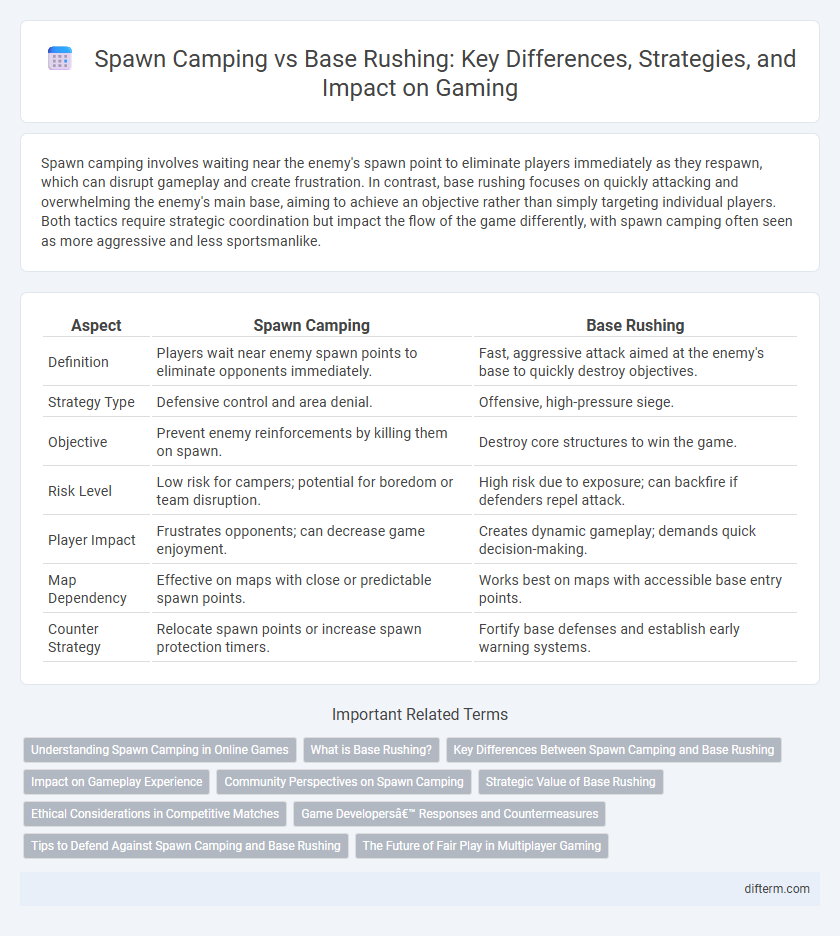Spawn camping involves waiting near the enemy's spawn point to eliminate players immediately as they respawn, which can disrupt gameplay and create frustration. In contrast, base rushing focuses on quickly attacking and overwhelming the enemy's main base, aiming to achieve an objective rather than simply targeting individual players. Both tactics require strategic coordination but impact the flow of the game differently, with spawn camping often seen as more aggressive and less sportsmanlike.
Table of Comparison
| Aspect | Spawn Camping | Base Rushing |
|---|---|---|
| Definition | Players wait near enemy spawn points to eliminate opponents immediately. | Fast, aggressive attack aimed at the enemy's base to quickly destroy objectives. |
| Strategy Type | Defensive control and area denial. | Offensive, high-pressure siege. |
| Objective | Prevent enemy reinforcements by killing them on spawn. | Destroy core structures to win the game. |
| Risk Level | Low risk for campers; potential for boredom or team disruption. | High risk due to exposure; can backfire if defenders repel attack. |
| Player Impact | Frustrates opponents; can decrease game enjoyment. | Creates dynamic gameplay; demands quick decision-making. |
| Map Dependency | Effective on maps with close or predictable spawn points. | Works best on maps with accessible base entry points. |
| Counter Strategy | Relocate spawn points or increase spawn protection timers. | Fortify base defenses and establish early warning systems. |
Understanding Spawn Camping in Online Games
Spawn camping in online games involves players targeting opponents immediately as they re-enter the game, often creating an unfair advantage by limiting their chances to react or strategize. This tactic disrupts gameplay balance and can cause frustration, reducing overall player engagement and enjoyment. Understanding spawn camping highlights the importance of game design elements like spawn protection and map layout to ensure fair and competitive experiences.
What is Base Rushing?
Base rushing is an aggressive gaming strategy where players quickly advance towards the enemy's spawn point or base to overwhelm defenders and secure a rapid victory. Unlike spawn camping, which involves targeting enemies as they respawn, base rushing emphasizes speed and coordinated assault to capture or destroy key objectives. This tactic is common in competitive multiplayer games like first-person shooters and real-time strategy titles, requiring precise teamwork and map knowledge.
Key Differences Between Spawn Camping and Base Rushing
Spawn camping involves players positioning themselves near the enemy's spawn point to eliminate opponents as they appear, prioritizing control and kill count at the expense of strategic movement. Base rushing focuses on aggressively attacking and infiltrating the enemy's main base or stronghold to achieve objective-based victories, emphasizing speed and teamwork over repetitive eliminations. The key difference lies in spawn camping targeting enemy respawn zones for tactical advantage, while base rushing targets critical infrastructure for rapid game progression.
Impact on Gameplay Experience
Spawn camping creates frustration by repeatedly eliminating players as they respawn, disrupting game balance and reducing team morale. Base rushing increases game intensity by driving fast-paced attack strategies, often forcing defenders to adapt quickly or lose control. Both tactics significantly influence player engagement, with spawn camping generally seen as negative and base rushing adding excitement to the gameplay experience.
Community Perspectives on Spawn Camping
Spawn camping in gaming often generates polarized community perspectives due to its perceived unfairness and potential to diminish gameplay enjoyment. Many players view spawn camping as a disruptive tactic that undermines game balance by targeting opponents immediately upon respawning, reducing opportunities for counterplay. Conversely, some argue that avoiding spawn camping requires strategic adaptation and map awareness, reflecting a skill-based challenge embraced by competitive players.
Strategic Value of Base Rushing
Base rushing offers significant strategic value by forcing opponents into reactive defense, disrupting their resource allocation and denying them control over critical map areas. Unlike spawn camping, which can be predictable and risk exposure, base rushing maximizes pressure and accelerates game momentum shifts by targeting crucial infrastructure and production capabilities. Effective base rushing exploits timing windows and teamwork coordination, often leading to swift victories or substantial territorial gains.
Ethical Considerations in Competitive Matches
Spawn camping and base rushing raise ethical considerations in competitive gaming, as both tactics can impact fairness and player experience. Spawn camping often disrupts gameplay by trapping opponents immediately upon respawning, leading to frustration and potential imbalances in match outcomes. Base rushing, while aggressive, challenges teamwork and strategy but maintains a level of engagement that respects the flow of competition.
Game Developers’ Responses and Countermeasures
Game developers employ various countermeasures to address spawn camping and base rushing, including implementing spawn protection zones and dynamic spawn point rotation to prevent immediate player elimination. Designing maps with multiple access routes and placing defensive structures strategically helps balance offense and defense, reducing frustration from base rushing tactics. Regular updates and player feedback integration are critical for fine-tuning game mechanics to ensure fair and engaging multiplayer experiences.
Tips to Defend Against Spawn Camping and Base Rushing
Effective strategies to defend against spawn camping include establishing choke points with traps or turrets, using smoke grenades or flashbangs to obscure vision, and constantly rotating spawn locations when possible. To counter base rushing, reinforce entry points with barricades, deploy defensive structures like automated sentries, and maintain a well-coordinated team communication to quickly respond to breaches. Prioritize map awareness and resource management to sustain prolonged defenses against aggressive enemy tactics.
The Future of Fair Play in Multiplayer Gaming
Spawn camping and base rushing remain contentious strategies shaping multiplayer gaming dynamics, prompting developers to innovate fair play mechanisms. Advanced AI-driven spawn protection systems and adaptive map designs are emerging to balance risk and reward, reducing player frustration and maintaining competitive integrity. Esports organizations increasingly enforce codes of conduct to foster sportsmanship, signaling a future where fair play and strategic diversity coexist harmoniously.
spawn camping vs base rushing Infographic

 difterm.com
difterm.com